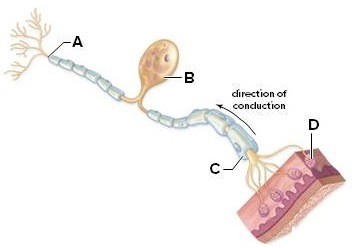________ inhibitors bind the enzyme at a location other than the active site but still interfere with product formation
Fill in the blank with correct word.
Answer: Noncompetitive
You might also like to view...
Compare and contrast the digestive process in animals with two-way flow through their digestive
system and those that have a digestive system with one-way flow. What will be an ideal response?
Examine the picture to answer the following questions and identify the labeled structures.  A:________B:________C:________D:________E:Is the neuron pictured a sensory, association or motor neuron? What is its function?F:Is the neuron multipolar or unipolar? Explain your answer.
A:________B:________C:________D:________E:Is the neuron pictured a sensory, association or motor neuron? What is its function?F:Is the neuron multipolar or unipolar? Explain your answer.
What will be an ideal response?
In their 1953 paper on the double-helical structure of DNA, Watson and Crick famously wrote: "It has not escaped our notice that the specific pairing we have postulated immediately suggests a possible copying mechanism for the genetic material." What did they mean?
A. Sexually reproducing organisms swap their DNA. B. The sugar-phosphate backbone of DNA holds the helix together in a way that allows the genetic information to be copied. C. Each strand in a DNA double helix contains all the information needed to produce a complementary partner strand. D. When a cell divides, each DNA helix is split between the daughter cells.
Which observation is inconsistent with Haeckel's idea that "ontogeny recapitulates phylogeny"?
A. The pharyngeal clefts and branchial arches of embryonic mammals and reptiles never acquire the form seen in adult fish. B. All tetrapod embryos display pharyngeal clefts, a notochord, segmentation, and paddlelike limb buds. C. Snakes and legless lizards develop "leg buds" as embryos, only to have them reabsorbed prior to hatching. D. In reptile embryos, two bones develop into the articular bones of the hinge of the jaw, while these same bones become the hammer and anvil of the inner ear in marsupials. E. The backbone